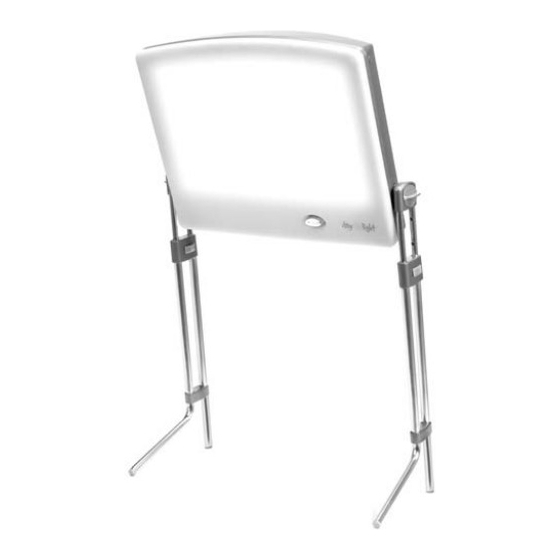
Advertisement
Quick Links
Day-Light User Guide
Safety Precautions
1. As with any electrical device, do not use the
Day-Light in or near water.
2. Do not overuse the Day-Light. Recommended
usage is 20-30 minutes each morning. Overuse may
cause irritability, excessive energy, or difficulty
falling asleep at bedtime.
3. It is not necessary to stare into the light. Feel free
to read, work, eat or talk on the phone during your
light therapy session. See page 7 for correct
positioning.
4. During the first few uses, your Day-Light may give
off an odor; this is harmless. This will not affect
the use of your Day-Light and will quickly
disappear.
Light energy can interact with and damage skin and eye tissues, especially when a photosensitizing mole-
cule – whether from a drug or produced by the body – is bound within those tissues. The highest risk is
with invisible ultraviolet (UV) light, which has been filtered out of the Day-Light system. In addition, there
are certain pre-existing medical conditions of eyes and skin (e.g., retinal dystrophies, age-related macular
degeneration, porphyria, lupus erythematodes, chronic actinic dermatitis and solar urticaria) that can show
photosensitized reactions to intense visible light. In such cases, bright light therapy should be adminis-
tered only under guidance of an ophthalmologist or dermatologist, as indicated. Ophthalmologists should
keep in mind that in some genetic retinal diseases the eyes are especially light-sensitive. Certain medica-
tions also are known to photosensitize skin and/or retinal tissues. Examples in the visible range of light
include neuroleptic drugs (e.g., phenothiazine), psoralen drugs, antiarrhythmic drugs (e.g., amiodarone),
antimalarial and antirheumatic drugs, porphyrin drugs used in photodynamic treatment of skin diseases,
and St. John's Wort (hypericum). Bright light therapy should not be used concurrently with these
drugs. Melatonin can be used in conjunction with light therapy at opposite times of day (e.g., evening and
morning), but if used concurrently, it can cause photosensitization. Drugs that photosensitize primarily in
the UVA range (just below 400 nm) may also have a "tail" of light absorption that extends into the lower
visible range (just above 400 nm), which could cause photosensitization. Examples are tetracycline, diu-
retic drugs (e.g., hydrochlorothiazide), sulfonamide drugs and tricyclic antidepressants (e.g., imipramine,
nortriptyline, desipramine, amitriptyline).
apy should be discontinued unless substitute medication is available, or administered with protective
measures under medical supervision. [Sources: Vincent DeLeo, M.D., St. Luke's-Roosevelt Medical Center,
New York; Charlotte Remé, M.D., University of Zurich, Switzerland.]
The Day-Light is an innovative light supply system – not a medical device. We recommend that you
consult a physician before undertaking a bright light therapy regime, especially if you suffer from a
mood disorder such as depression, are on prescription medications, have a history of eye conditions, or
are under a physician's care for any reason.
CAUTION
If such a reaction is experienced or suspected, bright light ther-
Disclaimer
By Uplift Technologies Inc.
Advertisement

Summary of Contents for Uplift Technologies Day-Light
- Page 1 – whether from a drug or produced by the body – is bound within those tissues. The highest risk is with invisible ultraviolet (UV) light, which has been filtered out of the Day-Light system. In addition, there are certain pre-existing medical conditions of eyes and skin (e.g., retinal dystrophies, age-related macular degeneration, porphyria, lupus erythematodes, chronic actinic dermatitis and solar urticaria) that can show photosensitized reactions to intense visible light.
- Page 2 Whether used as a task light, reading lamp, or placed on the shelf for enjoyable ambient light, your Day-Light can be put to good use for much more than your regular 20-30 minute light therapy session each morning.
- Page 3 This section explains how to remove and install the light Check Package Contents tubes, and how to install the legs of your Day-Light. To discover all the versatile features of your Day-Light, Your Day-Light comes with the following components: please read this section.
- Page 4 You may prefer the lower intensity setting when using tube from the retainer clip at the other end. your Day-Light for work or ambient lighting – it’s your To Install a Light Tube choice. However, the lower setting emits a light intensity 1.
- Page 5 When not using your Day-Light for light therapy, you Repeat assembly for the left leg. can easily convert it to a task lamp by placing the light over or near your work space. To Adjust the Height of the Light There are three leg heights available on your Day-Light: Maximum height −...
- Page 6 Using Your Day-Light for Light Therapy ous kinds, as well as circadian sleep disorders. Some- It is best to use your Day-Light with the legs for light times bright light is used in conjunction with drugs, therapy. As described previously, tilt the light at a 15°...
- Page 7 The recommended light dosage is 10,000 lux which Although it is fine to read while using the Day- is achieved by sitting 12" from the Day-Light. Light, the light must be able to reach your eyes. It is not necessary, or recommended to sit any With the head in this position, light cannot reach closer to the light or to stare directly into the light.
-
Page 8: Warranty
This excludes light tubes. Damage due to neglect or misuse is not warranted, nor is this warranty transferable. If the Day-Light is defective in material or workmanship Uplift Technologies Inc. will, at its discretion, either repair or replace your Day-Light as follows: During the first year at no charge except for the current delivery charge •...

